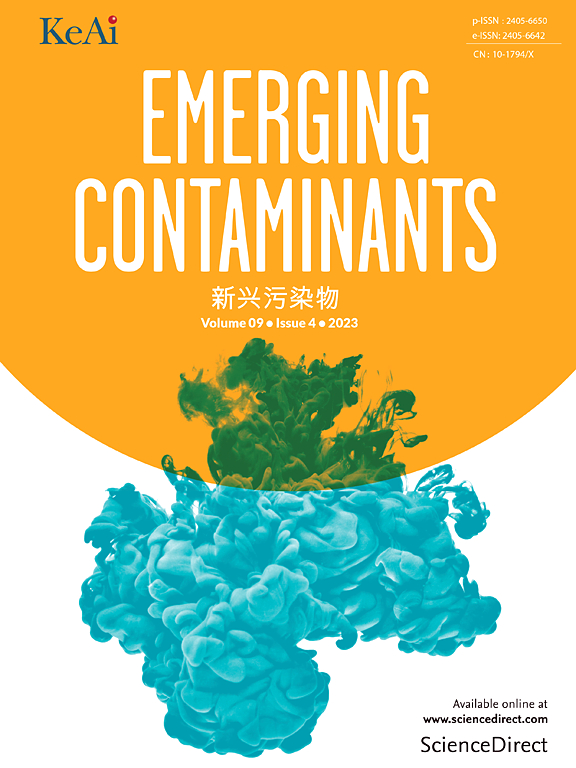释放基于受体的检测在高通量检测中的力量:评估酶联免疫吸附法在大规模抗生素监测中的可行性
IF 6.9
2区 环境科学与生态学
Q1 ENVIRONMENTAL SCIENCES
引用次数: 0
摘要
在水生环境中检测到抗生素,其发生率和相关风险水平具有异质性。因此,大尺度的高时空分辨率监测对于更好地应对其风险至关重要。质谱(MS)技术是敏感和精确的,但复杂,昂贵和耗时的抗生素检测。酶联免疫吸附测定(ELISA)是一种成熟的基于受体的测定方法,它提供了一种具有成本效益的替代方法,并以其高通量分析能力而特别值得注意。但其在环境监测方面的高通量能力尚未得到充分发挥。ELISA非常快速(每天检测3800 - 37000次),价格低廉(每次检测1.8美元,资本成本从3.5万美元到27万美元不等),并且用于检测经常报告的抗生素(可获得97个商用试剂盒)。采用固相萃取法,其检出限低至0.125 ng/L。他们的定量结果是稳健的,因为他们也普遍同意那些质谱方法。目前比较保守的方法是采用ELISA法对大量样品进行初步筛选,然后通过质谱法对一小部分“阳性”样品进行定量。然而,ELISA的适用性还有待进一步提高,如制定标准化的ELISA定量程序和基于微流体芯片的ELISA试剂盒和仪器。本文章由计算机程序翻译,如有差异,请以英文原文为准。
Unleashing the power of receptor-based assay on high-throughput detection: Assessing the feasibility of enzyme-linked immunosorbent assay on large-scale antibiotic monitoring
Antibiotics are detected in aquatic environments with heterogeneity in their occurrence and associated risk levels. Thus, high spatiotemporal resolution monitoring in a large scale is essential to better cope with their risks. Mass spectrometry (MS) techniques are sensitive and precise, yet complex, expensive, and time-consuming for antibiotic detection. The enzyme-linked immunosorbent assay (ELISA) is among a mature receptor-based assays that offer a cost-effective alternative and are particularly notable for their high throughput analytical capabilities. However, its high throughput power on environmental monitoring is underutilized. ELISA is remarkably rapid (3800–37,000 tests per day), inexpensive ($1.8 per test, capital costs ranging from $35,000 to $270,000), and ready-to-use (97 commercial kits available) for detecting frequently reported antibiotics. Adopting solid phase extraction decreases their limits of detection to as low as 0.125 ng/L. Their quantification results are robust as they also generally agreed well with those of MS methods. A conservative way at present is to use ELISA for initial screening of large numbers of samples, with subsequent quantification of a small proportion of “positive” samples through MS methods. Yet, the applicability of ELISA can be further improved, such as developing a standardized quantification procedure for ELISA and microfluid chip-based ELISA kits and instruments.
求助全文
通过发布文献求助,成功后即可免费获取论文全文。
去求助
来源期刊

Emerging Contaminants
Medicine-Public Health, Environmental and Occupational Health
CiteScore
10.00
自引率
6.70%
发文量
35
审稿时长
44 days
期刊介绍:
Emerging Contaminants is an outlet for world-leading research addressing problems associated with environmental contamination caused by emerging contaminants and their solutions. Emerging contaminants are defined as chemicals that are not currently (or have been only recently) regulated and about which there exist concerns regarding their impact on human or ecological health. Examples of emerging contaminants include disinfection by-products, pharmaceutical and personal care products, persistent organic chemicals, and mercury etc. as well as their degradation products. We encourage papers addressing science that facilitates greater understanding of the nature, extent, and impacts of the presence of emerging contaminants in the environment; technology that exploits original principles to reduce and control their environmental presence; as well as the development, implementation and efficacy of national and international policies to protect human health and the environment from emerging contaminants.
 求助内容:
求助内容: 应助结果提醒方式:
应助结果提醒方式:


